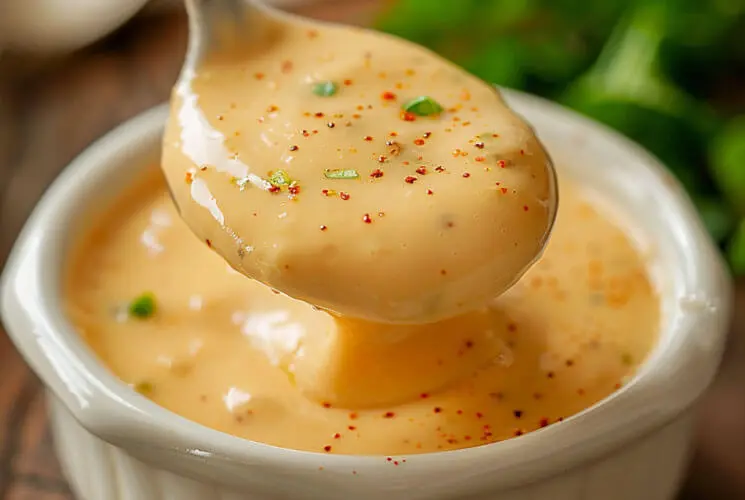Melt-in-Your-Mouth Goodness: Why This Cheese Sauce Recipe Is a Must-Try
There’s something undeniably satisfying about the moment warm, velvety cheese sauce hits your plate. Whether it’s smothering a pile of fries, hugging a bowl of macaroni, or dripping from a roasted veggie spear, cheese sauce makes everything better.
This recipe isn’t just creamy and cheesy—it’s a kitchen essential. It comes together in minutes and works for just about anything: mac and cheese, nachos, baked potatoes, burgers, steamed broccoli, you name it.
While store-bought cheese sauces might seem convenient, they often taste flat, overly salty, or packed with preservatives. A homemade version? It’s fresher, more flavorful, and customizable to your liking—whether you want it spicy, smoky, rich, or light.
Best of all, this recipe is quick, budget-friendly, and made with simple ingredients you already have on hand. No more mystery ingredients or plastic squeeze bottles. Just real, melty goodness, ready to elevate your next dish with ease.
Essential Ingredients for a Creamy Cheese Sauce Recipe
This cheese sauce starts with a classic roux and builds into something deliciously smooth and luscious. Here’s what you’ll need:
Butter + Flour
The roux base! Melted butter and flour whisked together gives the sauce structure and that velvety thickness.
Whole Milk or Half-and-Half
You need a creamy liquid to turn your roux into a silky sauce. Whole milk provides richness, while half-and-half brings an extra luxurious texture.
Cheese (Your Choice!)
-
Sharp cheddar: for bold flavor
-
Mozzarella: for melt and stretch
-
Gouda or Fontina: for creamy smoothness
-
American cheese: classic and ultra-melty
Pro Tip: Combine two cheeses for more depth—like sharp cheddar + mozzarella or gouda + cream cheese.
Optional Add-ins
-
Garlic powder or minced garlic for savory depth
-
Dijon mustard for tang
-
Cream cheese for extra creaminess
-
Cayenne or smoked paprika for a little kick
Ingredient Swaps for Dietary Needs
-
Gluten-free flour or cornstarch for a GF version
-
Lactose-free milk or unsweetened oat milk for dairy-sensitive folks
-
Vegan cheese + plant-based milk for dairy-free alternatives
Step-by-Step: How to Make Cheese Sauce From Scratch
Making cheese sauce from scratch is much easier than it seems. Here’s how to nail it every time:
Make the Roux
In a medium saucepan, melt 2 tablespoons of butter over medium heat. Once melted, whisk in 2 tablespoons of flour. Keep whisking for 1–2 minutes until the mixture is golden and bubbling—this cooks off the raw flour taste.
Add the Milk
Slowly pour in 1½ cups of warm milk, whisking continuously to prevent lumps. Let it gently simmer for 3–5 minutes, stirring often, until the mixture thickens and coats the back of a spoon.
Add the Cheese
Turn the heat down to low. Stir in 1½ cups of shredded cheese, a handful at a time, until melted and silky smooth. Don’t rush—gentle heat is the key to preventing a grainy texture.
Season to Taste
Add salt, pepper, and any of your favorite mix-ins like garlic powder or mustard. Stir until well blended.
Pro Tip:
Always grate cheese fresh off the block! Pre-shredded cheese contains anti-caking agents that can make your sauce gritty or clumpy.
Common Mistakes to Avoid (And How to Fix Them)
Even a simple cheese sauce can run into issues. Here’s how to spot and solve the most common problems:
Too Thin
-
Simmer the sauce longer, or whisk in a slurry of cornstarch and milk.
Too Thick
-
Add a splash of warm milk to loosen it to your desired consistency.
Grainy or Oily Texture
-
Caused by overheating or using pre-shredded cheese. Stick to fresh cheese and keep heat low.
Curdled Sauce
-
Happens when cheese is added to a too-hot base. Lower your heat and add cheese gradually.
Fix-it Tip
Blend it! If your sauce goes grainy, a quick blitz with an immersion blender can help smooth it out.
Flavor Boosters & Add-Ins for Next-Level Cheese Sauce
This is where the fun begins! Amp up your cheese sauce with bold flavors and exciting add-ins:
Spices & Seasonings
-
Garlic powder or roasted garlic
-
Dijon or yellow mustard
-
Smoked paprika or cayenne for smoky heat
-
Nutmeg (just a pinch!) for white sauces
Liquid Upgrades
-
Hot sauce: Great for nacho cheese
-
Beer: Perfect for a pub-style sauce
-
White wine: Adds depth to fancier dishes
Tasty Mix-ins
-
Caramelized onions or shallots
-
Chopped jalapeños for heat
-
Fresh herbs like chives or parsley
-
Crispy bacon or pancetta crumbles
Advertisement
Want Tex-Mex vibes? Stir in a splash of salsa and a sprinkle of taco seasoning. Craving an upscale twist? Add a little truffle oil or swap in gruyère.
Delicious Cheese Sauce Variations You’ll Want to Try
Why stick to just one version of cheese sauce when you can have a whole lineup of crave-worthy options? Here are some creative variations to suit every taste and lifestyle:
Nacho Cheese Sauce
Add cheddar, a splash of milk, and a bit of hot sauce or jalapeño juice. For extra creaminess, stir in a little cream cheese or evaporated milk. Perfect for tacos, nachos, and game-day snacks.
White Cheese Sauce
Use mozzarella, Monterey Jack, or cream cheese for a mild and silky sauce. Add garlic and a pinch of nutmeg—great for pasta, chicken, or veggie casseroles.
Vegan Cheese Sauce
Blend soaked cashews, nutritional yeast, garlic powder, lemon juice, and unsweetened almond or oat milk. A great plant-based option for mac and cheese, broccoli, or rice bowls.
Low-Carb / Keto Cheese Sauce
Ditch the flour and melt cream cheese and heavy cream with shredded cheddar or gouda. Rich, decadent, and ideal for keto casseroles and steamed veggies.
Gluten-Free Cheese Sauce
Use cornstarch or a GF flour blend in the roux. Everything else stays the same—no flavor compromise!
Pairing Tip:
-
Nacho sauce → tortilla chips, chili
-
White sauce → roasted cauliflower, pasta
-
Vegan → sweet potatoes, grain bowls
-
Keto → broccoli, grilled meats
How to Store & Reheat Cheese Sauce Properly
Got leftovers? Here’s how to keep your cheese sauce tasting fresh and smooth.
Refrigeration
Let the sauce cool completely, then transfer to an airtight container. Store in the fridge for up to 4–5 days. Stir before reheating to restore consistency.
Reheating
Gently warm the sauce on low heat, adding a splash of milk or cream to loosen it up. Stir frequently to avoid sticking or separation.
Freezing Tips
You can freeze cheese sauce, but it may lose some creaminess. To minimize this:
-
Freeze in small portions
-
Wrap tightly in plastic wrap and foil
-
Thaw overnight in the fridge
-
Reheat slowly with milk to smooth it out
Avoid clumps by keeping heat low and whisking constantly.
Best Ways to Use Your Homemade Cheese Sauce
This sauce is more than a dip—it’s your kitchen’s secret weapon for quick, comforting meals.
Mac and Cheese
Toss it with elbow pasta, top with breadcrumbs, and bake until bubbly. Add bacon, peas, or jalapeños to mix things up.
Veggies & Potatoes
Pour it over steamed broccoli, roasted cauliflower, or baked potatoes for a family-friendly side that even picky eaters will love.
Dipping Sauce
Serve warm with soft pretzels, tortilla chips, fries, or even veggie sticks. Add crushed red pepper for a spicy twist.
Sandwich Spread
Use it as a gooey layer in burgers, grilled cheese, or chicken sandwiches. It adds richness and binds flavors together.
Pasta Bakes
Mix into your favorite casseroles or pasta bakes for a creamy, cheesy finish that holds up well in the oven.
Weeknight Tip:
Make a big batch, portion it into jars, and use it all week—on veggies, eggs, wraps, or toast!
FAQs – People Also Ask
How do you thicken cheese sauce without flour?
Use a cornstarch slurry (1 tablespoon cornstarch + 2 tablespoons cold milk), or mix in cream cheese for thickness. You can also reduce the sauce by simmering it longer.
Why is my cheese sauce grainy?
It likely got too hot, or you used pre-shredded cheese, which contains anti-caking agents that interfere with smooth melting. Always use freshly grated cheese and low heat.
Can I use plant-based milk?
Absolutely. Just choose unsweetened, unflavored varieties like almond, oat, or soy milk. Cashew milk works especially well in vegan sauces.
What’s the best cheese for sauce?
-
Cheddar: sharp and flavorful
-
Mozzarella: stretchy and mild
-
Gouda or Fontina: creamy and melty
-
American cheese: processed, but smooth and consistent
A blend of cheeses gives you the best of all worlds—flavor, melt, and texture.
Can you freeze cheese sauce?
Yes, but the texture may change slightly. Thaw slowly in the fridge and reheat gently with added milk. A quick blend with an immersion blender can help restore smoothness.
Final Thoughts: Cheese Sauce Recipe That Brings People Together
There’s something magical about a pot of warm cheese sauce—it’s comfort, creativity, and crowd-pleasing flavor all in one.
Whether you’re dipping fries, layering lasagna, or simply sneaking spoonfuls straight from the pan, this recipe is guaranteed to satisfy. Customize it, double it, freeze it—make it yours.
Got a twist on this classic? Share your favorite cheese combos or add-ins in the comments below. Let’s keep the cheesy love flowing!

Homemade Cheese Sauce Recipe
Equipment
- Medium saucepan
- Whisk
- Cheese grater (recommended for fresh cheese)
- Measuring cups and spoons
Ingredients
- 2 tablespoons unsalted butter
- 2 tablespoons all-purpose flour or gluten-free alternative
- 1½ cups whole milk or half-and-half
- 1½ cups freshly shredded sharp cheddar cheese
- ¼ teaspoon garlic powder optional
- ½ teaspoon Dijon mustard optional
- Pinch of cayenne pepper optional
- Salt and black pepper to taste
Instructions
- Melt the Butter: In a medium saucepan over medium heat, melt the butter.
- Whisk the Roux: Add the flour and whisk constantly for 1–2 minutes, until the mixture is golden and bubbling.
- Add Milk Slowly: Gradually whisk in the milk, a little at a time, stirring constantly to avoid lumps.
- Simmer Until Thickened: Continue whisking for 3–5 minutes until the sauce begins to thicken.
- Add Cheese: Reduce heat to low. Add shredded cheese in small handfuls, stirring until completely melted and smooth.
- Season & Customize: Stir in garlic powder, mustard, cayenne, salt, and pepper to taste.
- Serve Warm: Use immediately over pasta, veggies, nachos, or as a dip.
Notes
- For extra creaminess, add 2 oz of cream cheese along with the shredded cheese.
- Use freshly shredded cheese to avoid a grainy texture—pre-shredded cheese has anti-caking agents.
- Make it gluten-free by using cornstarch (1 tbsp + 2 tbsp water slurry) instead of flour.
- Storage: Keep in an airtight container in the fridge for up to 5 days. Reheat slowly with a splash of milk.
- Freezing not recommended, but possible. Texture may need adjusting after thawing.

